
Day 1: Arrival & Wandering the Medina
– Arrive from Casablanca (4.5-hour drive into the Rif Mountains)
– Check in at Parador de Chefchaouen
– Explore the blue-painted medina at leisure
– Stop for mint tea & almond cookies in a café
– Dinner at Triana (don’t miss the goat cheese tart with honey)
– Evening walk up to the Spanish Mosque for sunset views
Day 2: Guided Tour & Local Experiences
– Start at Plaza Uta el-Hammam & Kasbah with a local guide
– Admire Andalusian doors, arches, and tiled details
– Visit a traditional bakery with wood-fired bread
– Walk to Ras El Ma spring & communal wash stations
– Lunch in a local home (vegetable tagine & mint tea)
– Dinner at Dar Echchaouen (terrace with mountain views)
Optional Day 3: Hike to the Akchour Waterfalls
Before starting my 15-day group tour of Morocco with AdventureWomen—a women-only trip I’d booked from Casablanca to Marrakech—with plenty of stops along the way—I added an optional pre-trip to Chefchaouen. The photographs looked amazing, and I figured, why not add a few extra days? I signed up without hesitation.
Known as “The Blue Pearl,” Chefchaouen is a small mountain town in northern Morocco, famous for its blue-painted streets and slower pace of life. The name itself comes from the Berber phrase for “watch the horns”—a reference to the twin mountain peaks that frame the town.

After arriving in Casablanca the day before, I joined a small group from the tour, and we drove about four and a half hours into the Rif Mountains. As we climbed higher, the air cooled and the roads narrowed. Then, there it was: Chefchaouen, spread across the hillside, looking as if almost every inch of it was blue.
The whole place looked almost surreal. Walls, doors, steps, even the alleyways—all painted in shades of blue, mostly somewhere in the indigo range. Some areas looked freshly painted, others faded or patchy. From soft blue to deep, faded indigo, the color seemed to be everywhere. I’d never seen a place so completely covered in blue, but somehow, it worked. It didn’t feel artificial. It just felt like it belonged.

People say the blue isn’t just for looks. Traditionally, natural indigo mixed with lime-based whitewash was used. The story goes that Jewish refugees who fled Spain in the 1400s—escaping forced conversion and persecution—settled here and brought the tradition of painting buildings blue. The color was meant to symbolize the sky, or something spiritual. Whether that’s exactly how it started or not, the blue stayed. Over time, it just became part of Chefchaouen itself.

These days, I’m not sure what most people use—whether it’s still something natural or just whatever paint is easiest to get—but the effect is the same: soft, calming blues that feel right against the mountains. From what I was told, homes are repainted often—sometimes several times a year.
And as for why? That depends who you ask. Some say it’s calming. Others say it keeps mosquitoes away. Some connect it to older spiritual beliefs. And for a lot of people, it’s just local pride. Whatever the reason, it’s beautiful. Honestly, it might be one of the most beautiful places I’ve been. And the sense of calm? That’s real.
Our hotel, Parador de Chefchaouen, was just outside the medina walls. It was simple but comfortable, with a courtyard and mountain views from the terrace. After checking in, I had the afternoon free to explore.
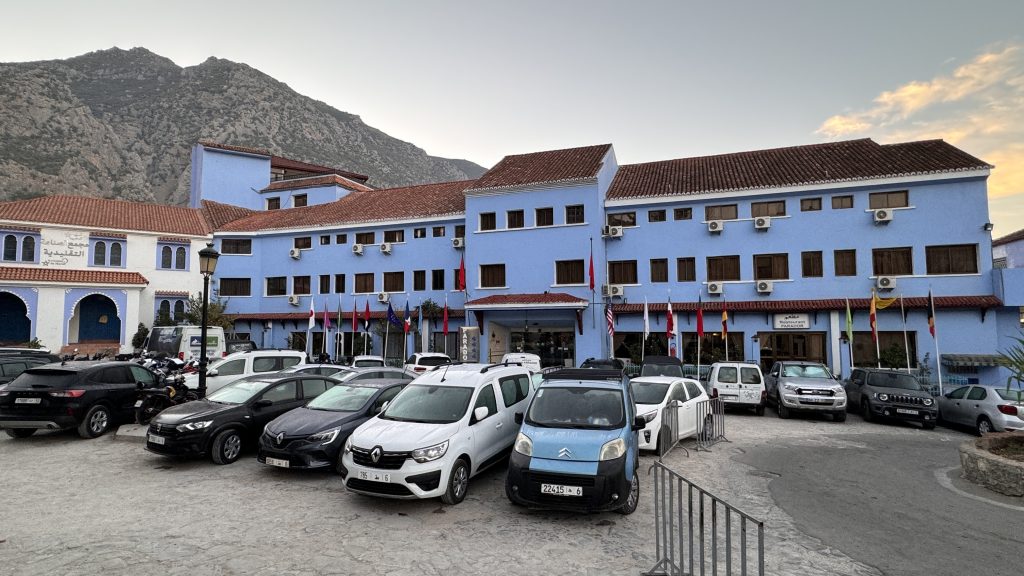
Chefchaouen isn’t a place with big sights or a long must-see list. It’s more a town to wander through. And that’s exactly what I did. I spent hours walking the medina’s narrow alleys without any plan. Every corner felt like a photo waiting to happen—or at least one I had to stop and take.

The shades of blue shifted as the light changed. I kept noticing details: blue benches built into walls, fountains with painted tiles, and countless doors—some plain and worn, others carved or decorated with ironwork. Many had tiled frames or bright potted plants. They weren’t trying to be beautiful—they just were.
The shops sold things unique to this area. I saw chichia hats—wide-brimmed woven hats trimmed with colorful wool pom-poms. Women from the Rif Mountains wear them for sun protection and, I was told, for good luck. Plenty were on display, and I saw women wearing them casually. Along with the hats, I noticed traditional wool coats—handwoven, warm garments called djellabas or burnous—sold in many shops throughout the medina.
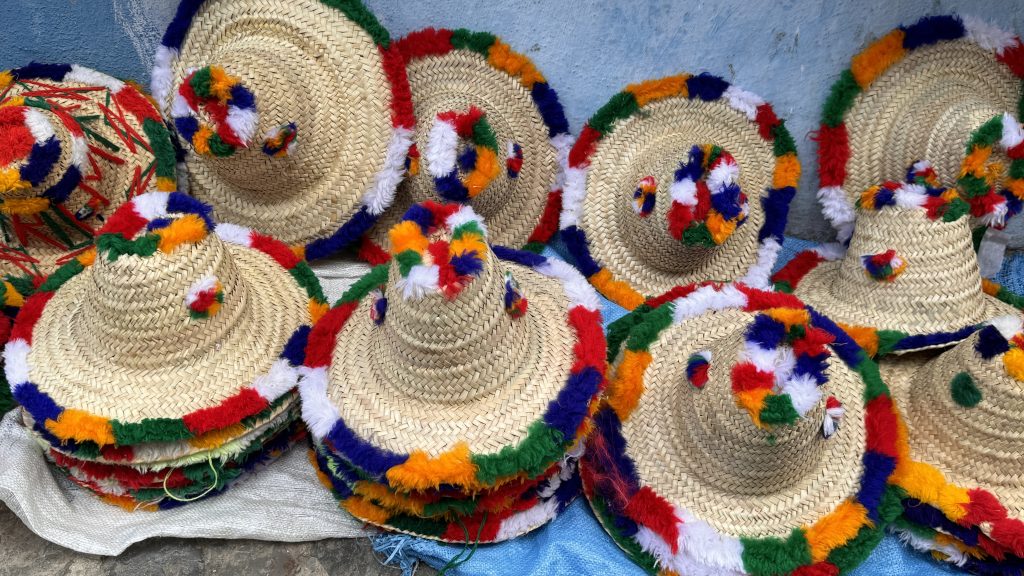
Leather goods, rugs, baskets, olive oil soap, and argan oil filled the shops too. Spices and dried fruit were common sights. Even small convenience stores had their own charm behind painted doors.

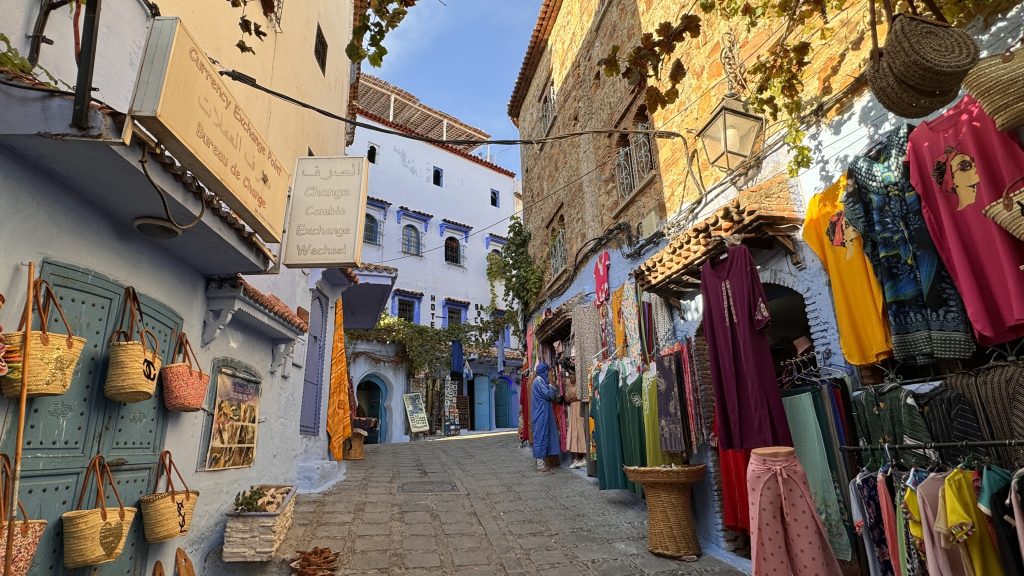

As I wandered through the medina, I noticed cats everywhere—lounging in blue doorways, perched on walls, napping on scooters, and even curled up on steps. They seemed completely at ease, like they belonged to the town as much as the blue paint and winding alleys. They were everywhere, quietly making the streets their own.
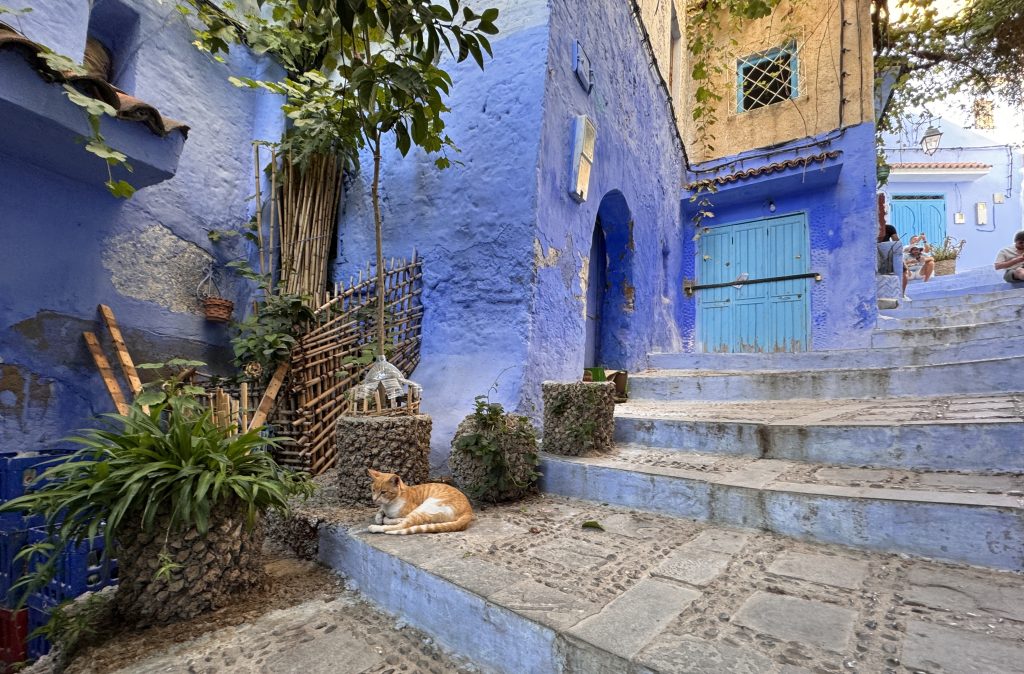


The medina is full of small cafés and terraces perfect for taking a break. I made sure to stop—once for mint tea and almond cookies, and another time for freshly made flatbread I couldn’t resist.
We ate at Triana, a casual restaurant inside the medina, on the recommendation of our guide. We made our way through the narrow, winding streets until we reached the restaurant. It was such a beautiful night that we chose to sit at a table on the outdoor terrace.
I ordered a goat cheese salad and a hot goat cheese tart drizzled with honey—which was fantastic. Goat cheese is a local specialty here, and the area is known for producing some of the best in Morocco. It showed in every bite.

Earlier that day, while wandering the medina, I’d noticed quite a few cats roaming freely. I mention this, because at dinner, several of them lingered near the patio where we sat.
I love cats, but I don’t usually feed animals at the table because it encourages bad behavior—and sure enough, that’s exactly what happened. Some diners fed the cats, which only encouraged them to get bolder as the evening wore on—and frankly, it felt out of hand. I found myself constantly shooing one particular cat away while trying to eat. One cat even jumped right onto my chair, then into my lap, and started eating from my unfinished tart. As much as I like cats, I have to admit, I found this pretty gross.

After dinner, I took a walk up to the Spanish Mosque, also called Bouzafar Mosque. The trail started just outside the medina walls and was a steady, gradual climb—taking about 20–30 minutes to reach the mosque. It’s a popular spot for locals and tourists to gather, and I quickly saw why.

From the top, the view of Chefchaouen below was stunning—the blue walls softened to lavender as the sun set behind the mountains. I found a quiet spot near the mosque, sat for a while, and soaked in the peaceful atmosphere, watching the town slowly light up as dusk settled in.

The next morning, we met our local guide—a woman from Chefchaouen itself—who led us on a deeper walk through the town. Wandering solo the day before had been peaceful, but hearing the stories behind the blue walls and narrow alleys gave the place more texture.
We started at Plaza Uta el-Hammam, the town’s central square (where I’d enjoyed a cup of mint tea the day before). Our guide explained that this square has always been the heart of Chefchaouen—where traders, families, and visitors naturally gather. On one side, the terracotta walls of the 15th-century Kasbah stand out against the surrounding blue—a reminder of Chefchaouen’s history as a defensive mountain stronghold.

As we left the square and continued through the medina, we passed more of the shops I’d wandered past the day before—though a few felt new, tucked along side alleys I hadn’t noticed. At one small workshop, a man sat weaving beside his displayed goods. A few shopkeepers nodded to our guide as we passed, but mostly, people just carried on with their morning routines.

From there, we headed down quieter side streets, where the architectural history really came alive. Elegant Andalusian arches framed doorways and windows, a clear reminder of the town’s Spanish influences. Many wooden doors were studded with iron nails arranged in decorative patterns—originally meant to protect them from damage and forced entry, but over time these nails became an artful feature.

Surrounding these doors, colorful hand-painted tiles added bursts of pattern and texture against the blue walls. I loved the uniqueness of the doors. No two seemed alike. Some were painted in shades of blue, from deep indigo to soft sky tones, while others stood out completely—painted green, or stained wood that showed off the grain.

The green doors surprised me, until I learned that green is considered a sacred color in Morocco, tied to blessings and prosperity. Some doors were simple, but many were covered in carved patterns—geometric shapes, starbursts, or delicate designs that looked hand-chiseled. In some places, the door itself felt like the focal point of the whole house, framed by archways or tilework like a piece of art.
It turns out, they’re not just decorative. Traditionally, square doors marked shops or storerooms, while rounded or arched doorways indicated private homes—a detail that traces back to the town’s Andalusian roots. And if anyone wants to change their doorway or repaint, they actually need permission from the city’s architectural office. There are regulations in place to help preserve Chefchaouen’s historic character, which explains why the medina still looks so consistent and timeless.
Mid-morning, we stopped by a small bakery that looked more like a home. Inside, a woman was baking fresh bread in a wood-fired oven. Rounds of khobz cooled in stacks while dough rested under cloths. She worked efficiently, shaping and flipping loaves, pausing only briefly as we watched.

At one point, we left the medina and followed a path toward Ras El Ma—the natural spring just outside the city walls. The name means “head of the water,” and it’s where fresh mountain water flows down into the valley, feeding the streams and rivers around Chefchaouen, including the Oued el Kebir.
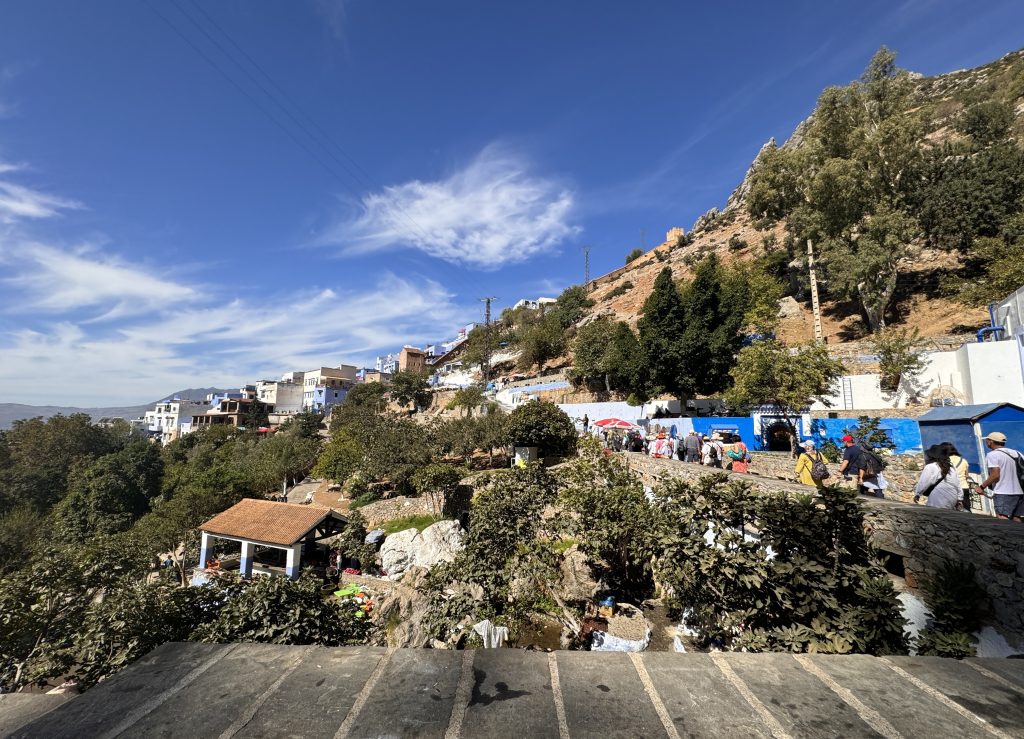
Our guide stopped to show us the communal wash station there. On both sides of the river, there are open washrooms where local women still come every day to do laundry. We saw a few of them that morning, standing over stone washboards, scrubbing clothes and chatting like it was just part of the routine—because it is.
Some laid their laundry out to dry on the rocks; others draped it over bars inside the washroom. It felt strange to watch, knowing how easily we throw clothes into a washing machine at home. But here, this was normal. Just part of daily life.

The highlight of the afternoon was having lunch at a local home. The house was simple and traditional, with hand-painted blue and white tiles on the walls and floors. We were shown around part of the home, which felt lived-in and typical for the area. Before the meal, fresh mint tea was served—a warm, welcoming start. Lunch was vegetable tagine, saffron rice, and fresh bread. It wasn’t fancy, but it was filling and delicious.


Over the past couple of days, I noticed a lot of everyday scenes that stuck with me: bright pink bougainvillea spilling over walls, rows of plant pots lined up on worn stone steps, local artisans quietly working at their looms or leather shops. Paintings and murals decorated some building exteriors, adding pops of color beyond the famous blue walls, as well as the locals going about their day.


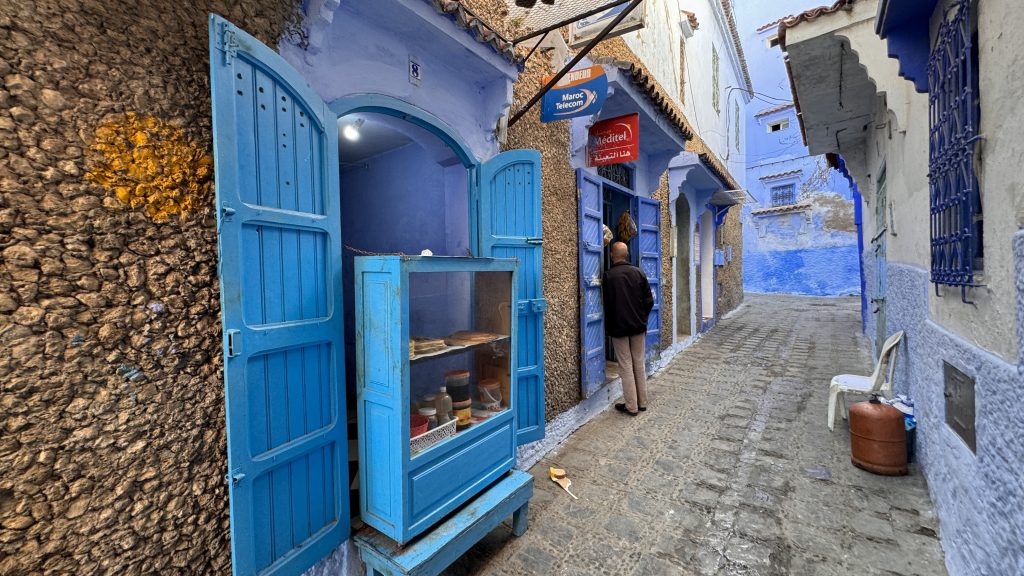
For dinner, we ate at the restaurant at our hotel, Dar Echchaouen, located just outside the medina. The place was stunning—sitting on a hill with beautifully manicured grounds and views over the mountains. We chose to sit on the terrace. The service was attentive, and the food was excellent. I had a vegetable tagine that was rich and flavorful, perfect after a day of walking. Perfect way to end our two days.

The next morning, we’d leave. But Chefchaouen had worked its quiet magic. Not just the color—but the pace, the people, and the small, everyday details I hadn’t known I’d come looking for.
Two days in Chefchaouen felt like the perfect introduction. I wandered the medina, soaked in the colors, shared local meals, and met people behind the blue walls. If I’d had a third day, I might’ve explored the nearby Akchour Waterfalls, but even without it, Chefchaouen left its quiet mark. The color, the calm, and the small details I didn’t know I’d been seeking.
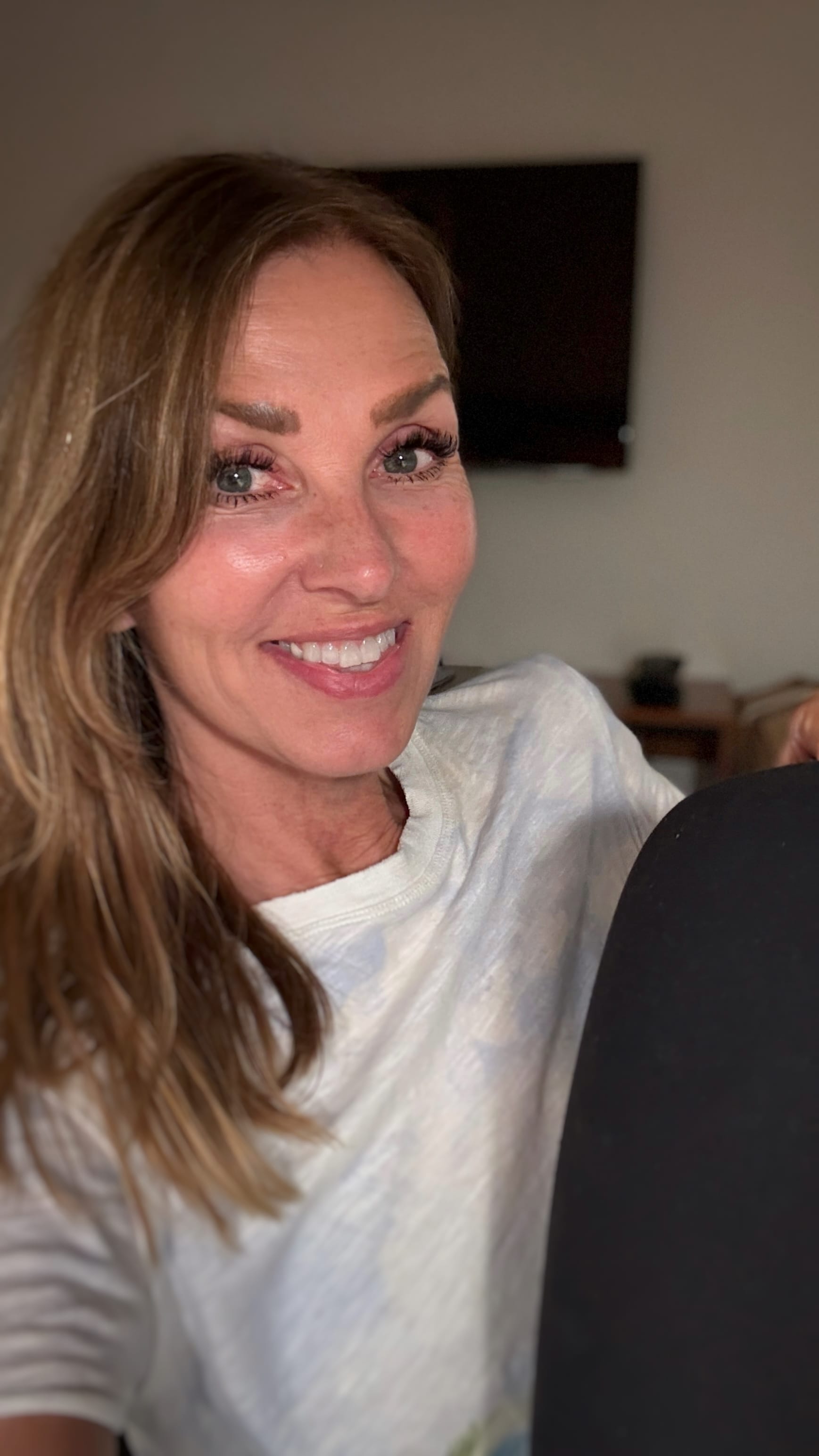
Hi, I’m JoAnne—writer, wanderer, and lover of places that surprise me. I’ve traveled to 60+ countries (and counting), usually with a camera in one hand and a notebook in the other. I’m drawn to mosaics, markets, and mountains, and I write to remember what moved me. When I’m not traveling, I’m working on my blog Travels Afoot, trying new creative projects, or planning my next adventure.